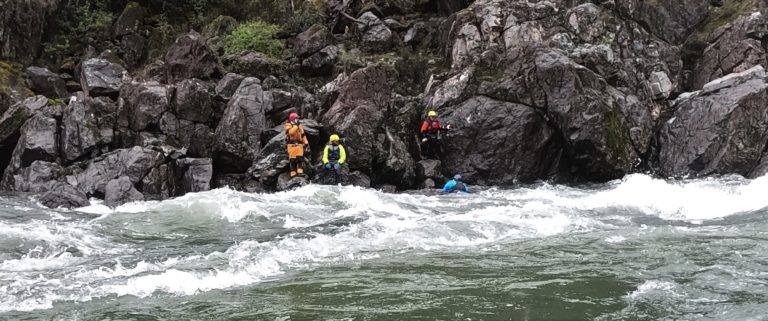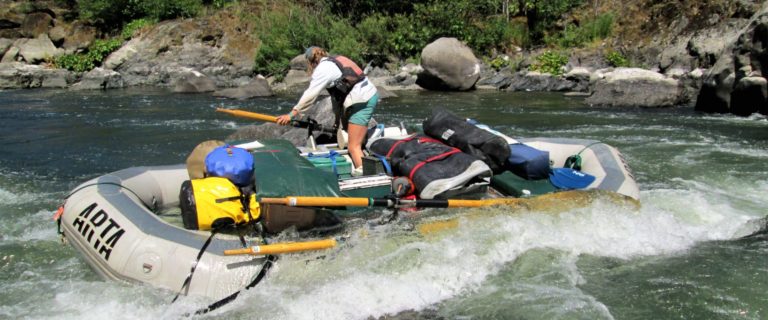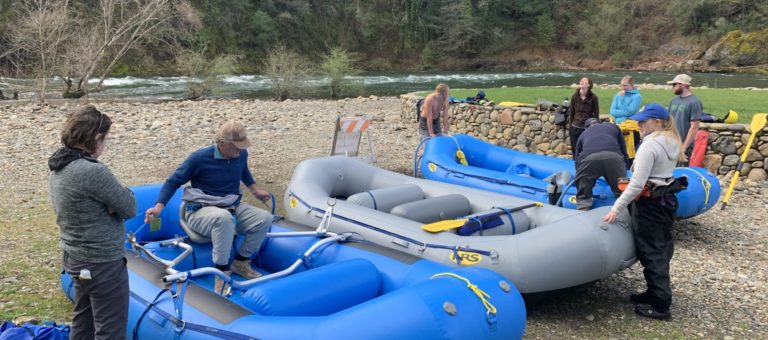While your whitewater safety talk is the most important pre-trip conversation, the paddle talk is almost as critical. A strong paddle talk, thorough paddle training and strong rafting commands will get your crew performing at a high level making it much more fun to guide your raft down the river.
The easiest way to improve your paddle training is to take a paddle raft guide school, advanced guide school or paddle on Cherry Creek …
The paddle commands that are simple, clear, and start with different words work best. The commands I use: forward, back paddle, right turn, left turn, stop, get down, back-on-the-job, over right and over left. Both “overs” start with the same word but it usually isn’t a problem since they are most often called to move to the downstream side of the raft. Later we will be discuss “overs” in more detail later.
The easiest way to improve your paddle training is to take a paddle raft guide school, advanced guide school or paddle on Cherry Creek or another technical class V river for a commercial company. Paddle rafting guide schools focus on how to create great paddlers and get them to work as a team. While the guides working class V rivers have spent years refining their paddle talks due to necessity. On these trips you’ll learn the whitewater rafting skills that the leaders in the industry are teaching their paddlers.
Video of Precise Whitewater Rafting Commands
The Basic Paddle Rafting Commands and Strokes
Forward paddle
Typically the most used rafting command is “forward” for forward paddle. A tripod position with weight on the feet, leaning forward and minimal weight on the butt while paddling aggressively will help keep people in the boat.
Here are some key points when teaching a forward paddle. Make sure the paddle shaft is perpendicular to the water. Paddlers need to lean forward to start the stroke and finish their strokes before their hips. Consequently, paddlers keep their weight on their feet and have better balance.
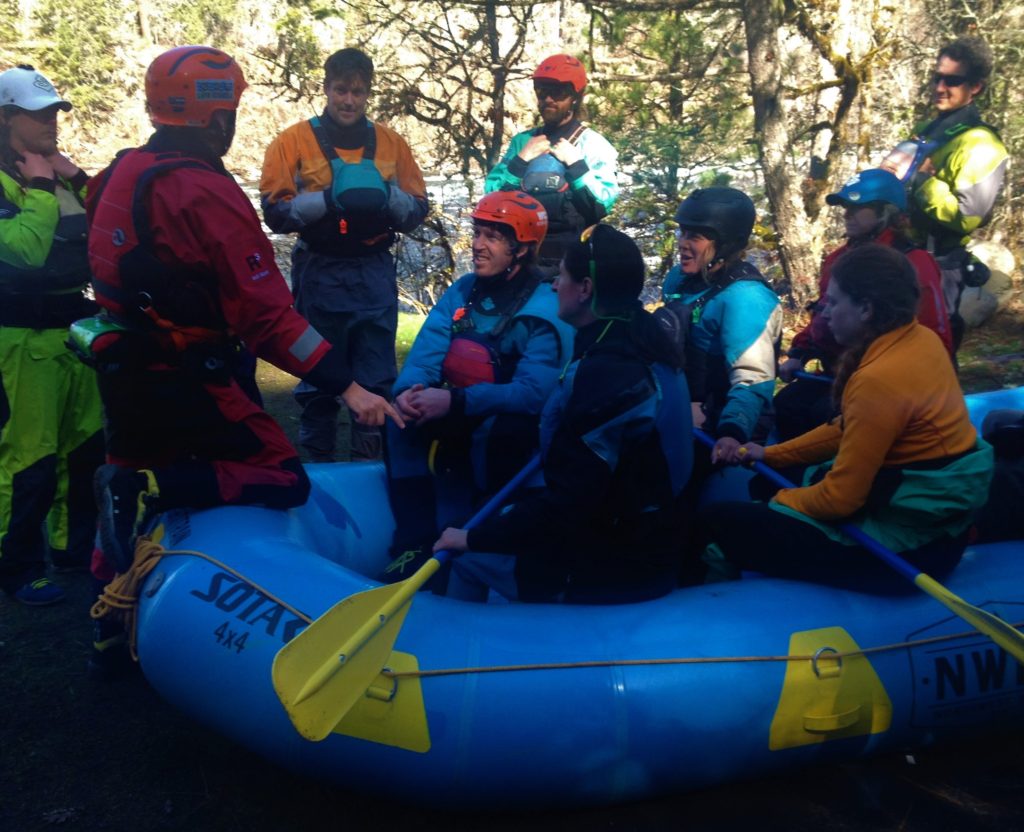
In the front of the boat, paddlers want to have their paddles follow along the bow of the boat at an angle. However, reaching straight forward and pulling straight back works better. If the front right paddler follows the bow of the boat she will drive the boat to the left. This makes it much harder for the guide to keep the raft on its desired route.
It is also important for paddlers to realize that they need to try to get the whole blade in the water every stroke. That requires adjusting in their waists as the raft tips side to side and forward to aft in the whitewater.
While some people prefer to say “forward paddle” the extra word is not neccessary. “Forward” is a clear, more concise command.
Back paddle
The key to back paddling is to slide your bottom hand up a bit and hold the paddle against your hip so you can use it as a fulcrum. Many times before giving a back paddle command, I’ll say “Ready to back paddle” to have the paddlers get in position. They will be leaning forward with the paddle shaft on their hips and the blade of the paddle behind them out of the water next to the raft ready to paddle.
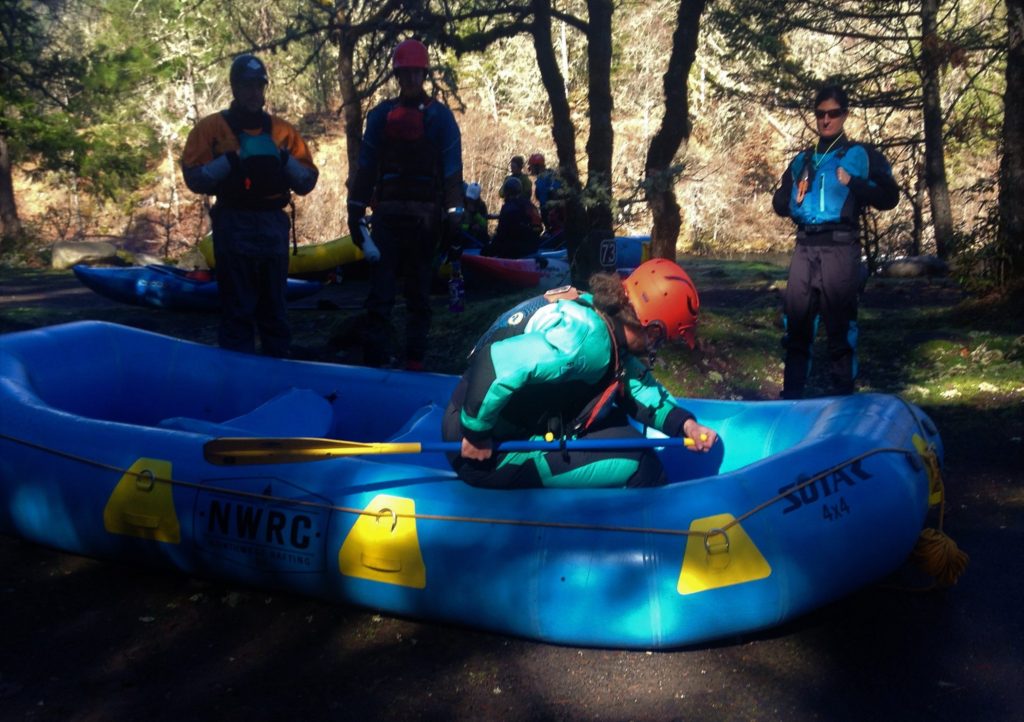
From that position when a back paddle is called, paddles are dropped into the water as paddlers move their bodies backwards and pull with the paddle T hand bending the shaft of the paddle on their hips.
Turns
Right turn and left turn our mirror images of each other. When paddlers here a turn is called, the side called back paddles while the other side forward paddles. For the “right turn” command, the right side of the boat back paddles and the left side of the boat forward paddles.
If you want your paddlers to be more advanced on the turn strokes the person in the bow forward paddling can follow the front tube during a turn to increase the efficiency of their stroke in helping turn the boat.
Stop
For the stop command rafters take their paddles out of the water and discontinue paddling.
Weighting the Boat Commands
Moving weight around in a paddle raft is one of the most under-rated whitewater rafting skills and needs to be practiced more often before these skills are needed.
Get Down
The get down command gets all the paddlers’ weight off the outside tubes and they sit in the bottom of the raft while still holding onto their paddles with two hands. This command makes the boat and paddlers much more stable when running large whitewater.
By taking all that weight off the outside tubes, the tubes ride higher and are less likely to be caught by currents, sucked down and cause flips.
Get downs make the center of gravity much lower so it is harder for the raft to flip and less likely for people to fall out of the boat. In addition, by taking all that weight off the outside tubes, the tubes ride higher. Therefore, the tubes catch less currents meaning fewer flips, dump trucks and swimmers.
Back on the Job
“Back on the job” is a command to tell paddlers to get back to their paddling positions after a get down or an over. A key part of training this command is to ensure the paddlers keep their hands on their paddle T’s while regaining a paddling position.
Overs (Hysides)
Overs are used to weight one tube of the raft or the other. For an “over right” the people on the right continue to sit on the right tube and the people on the left tube move across and get their chests on the right tube in a position in front of the person that normally sits across from them.
Once again make sure people are keeping their hands on their paddle T’s as they perform this command. In addition, make sure practice staying on the tube until they hear “back-on-the-job.”
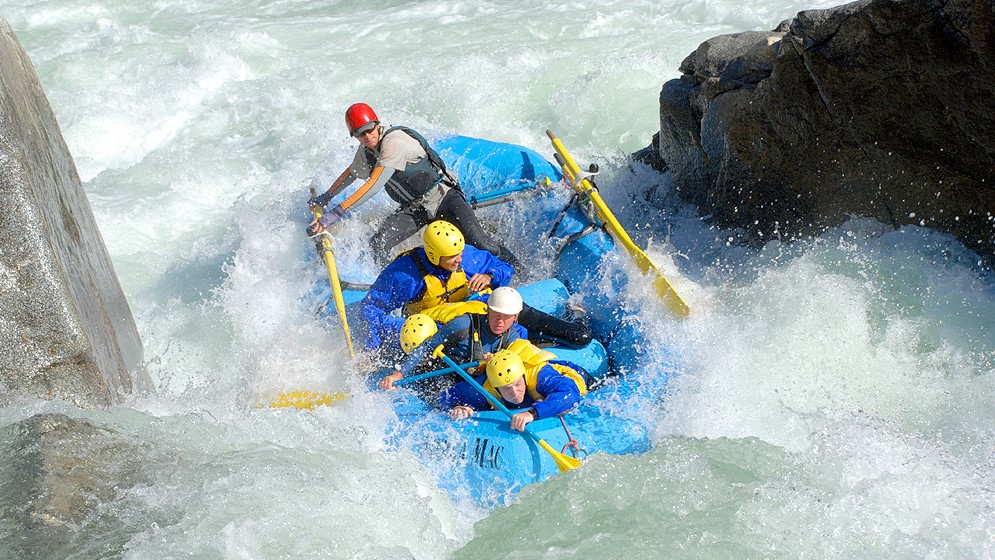
Personally I’m not a big fan of the high side command. Overs should be called before the raft hits a rock or wave. This keeps the downstream tube pressed deeply into the water and the upstream tube lifted out of the river. The upstream tube will not catch water and get pulled deep causing the raft to flip.
By the time a tube is the “hyside” it is too late.
Most rafts flip upstream so overs are almost always towards the downstream tube. By the time a tube is the “hyside” it is too late and people will most likely be swimming or the boat will wrap.
In addition overs are useful to low side boats through narrow shoots. They can also be used when a boat is perched on a rock to shift weight around and free the raft. A hyside command would be confusing in these situations.
Team Paddling in Whitewater
It is helpful to discuss with paddlers that it is more important that everyone paddles consistently and together rather than paddling just as hard as they can. Paddlers need to be predictable so guides will know how much power they are going to get when a command is called.
The front two paddlers are the key. They both need to enter their paddles into the water at the same time to the same depth, the same distance in front of the rafts, pull for the same time and exit together. If everyone behind follows the person in front of them the boat will surge forward.
Have the downstream paddler be the lead paddler that way both paddlers can be looking downstream to anticipate hits by waves and rocks.
Having the front two paddlers keep in sync can be tricky. Some people like to designate one of the two as the lead paddler and have the other follow. This works well on big volume rivers.
I prefer to have the downstream paddler be the lead paddler. That way both paddlers can be looking downstream to anticipate hits by waves and rocks. If the bow of the raft points to the right shore the front left paddler leads. When the bow points to the left shore the right front paddler is the lead paddler.
Being a Leader
While having precise commands and training paddle crews well is imperative, it is also key to create the positive environment in your raft. We’ve all seen those paddle rafts where the captain is screaming at their paddlers or giving mostly negative feedback. This type of behavior leads to a negative spiral and a negative experience.
Focus on what paddlers need to be doing. For example, saying “Remember to paddle together” is going to be more productive than “You’re not paddling together.” Rafting is supposed to be fun, remember to smile.
Paddler Overboard
Be sure to review what to do if a paddler falls in the river or if another raft flips. Only one paddler should assist a swimmer, the other paddlers need to be in position to maneuver the raft. Too many times one person falls in the river and everyone in the raft tries to rescue that person instead of continuing to paddle. The raft then rides up on another rock and more people fall in.
Similar problems arise when trying to rescue another raft. Train your crew to in general stay in position ready for paddle commands. The responsibility of the guide is to first keep the raft upright and keep people in the raft, then rescue those out of the raft. When a raft flips it helps to remind you crew, “Ok, we need everyone ready to paddle.”
Concluding Thoughts
Having a well trained paddle rafting crew will allow you to have more precise lines and do a better job of keeping people in the boat. Take time at put-in to work through all the whitewater rafting commands with your crew to properly develop their skills.
While paddle captaining the raft be sure to continue to practice and use your commands throughout the day. If you never use a turn and then call one late in the day, your crew will not perform the skill as well as if you had used them consistently.
Be sure to practice and use the commands throughout the day.
Finally think about the tone of your commands. It’s ideal when your voice sounds calm, confident and clear when in big whitewater rapids and stressful situations. Typically your paddlers will have more than enough adrenaline. Slowing your commands and promoting calm will help your team paddle together.
